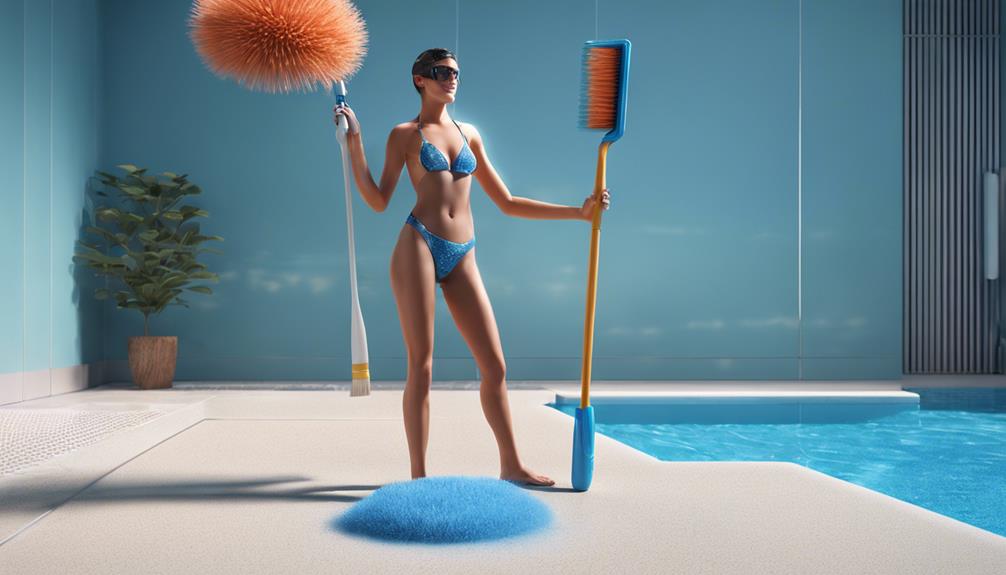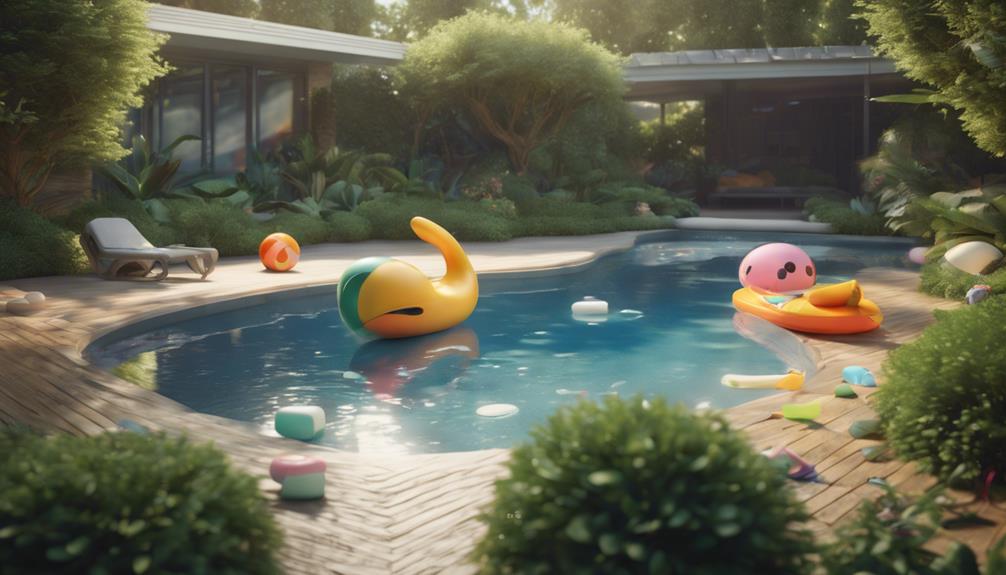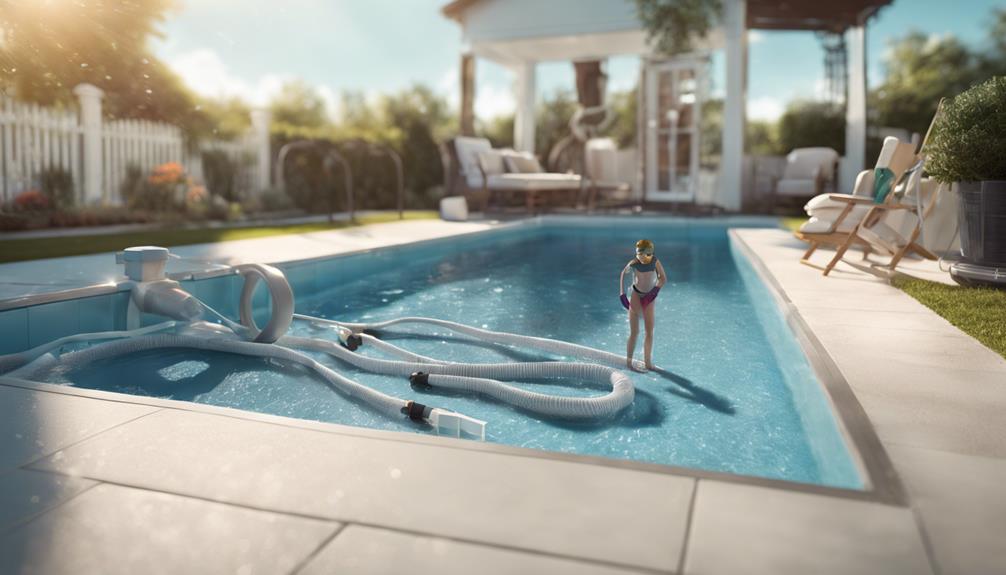To keep your pool sparkling clean and safe, you'll want to master these 10 essential DIY pool cleaning equipment maintenance tips. Start by daily skimming and debris removal, and emptying the skimmer basket regularly. Monitor pH levels and adjust as needed, and use a pool net to scoop out larger debris. Brushing and scrubbing techniques will help dislodge stubborn algae and grime. Regularly clean and maintain your filter, and vacuum with a wide suction path and adjustable suction control. Implement safety measures, inspect equipment regularly, and use alternative sanitizers like bleach. By following these tips, you'll be well on your way to a pristine pool – and there's even more to discover to keep your pool in top condition.
Key Takeaways
- Regularly clean the skimmer and its basket to ensure efficient debris removal and prevent clogs.
- Inspect and maintain the pool vacuum's filter and intake screens to prevent clogs and maintain suction power.
- Perform routine checks on the filter system, including backwashing and cleaning, to guarantee correct functioning.
- Monitor and adjust pH levels regularly to prevent equipment damage and ensure sanitizer effectiveness.
Daily Skimming and Debris Removal
You'll need to dedicate a few minutes each day to skimming the surface of your pool and removing any debris that's accumulated overnight.
This daily routine is vital for maintaining a clean and safe swimming environment.
Start by using your skimmer to remove floating debris, such as leaves and insects, from the surface of the water.
Make sure to empty the skimmer basket regularly to guarantee it continues to function efficiently.
Next, use a pool net to scoop out any larger debris that's sunk to the bottom of the pool.
Don't forget to clean the skimmer itself regularly to prevent clogs and maintain peak performance.
Proper daily skimming and debris removal won't only keep your pool looking its best, but also reduce the risk of clogged filters and pumps.
Ph Level Monitoring and Adjustment
As you've got your daily skimming and debris removal routine down pat, it's time to shift your focus to the chemical side of DIY pool cleaning equipment maintenance, starting with pH level monitoring and adjustment.
pH levels that are too high or too low can affect the performance of your sanitizer, causing eye irritation, skin problems, and even equipment damage.
To maintain proper pH levels, you'll need to test your pool water regularly using a reliable pH tester. Aim for a pH range of 7.2 to 7.8, as this is ideal for swimmers and allows your sanitizer to work effectively.
If your pH levels are off, adjust them accordingly by adding pH increaser or decreaser. Remember to always follow the manufacturer's instructions and take necessary safety precautions when handling chemicals.
Brushing and Scrubbing Techniques

When it comes to brushing and scrubbing your pool, you'll want to master the techniques that effectively remove algae and dirt.
You'll need to focus on specific areas, such as corners and the pool floor, using the right brush for your pool's surface material.
Algae Removal Techniques
To effectively remove algae from your pool, start by brushing the walls and floor in a circular motion to dislodge stubborn algae and grime. Use a nylon-bristled brush designed for your pool's surface material to avoid damaging it. Pay extra attention to corners, steps, and other hard-to-reach areas where algae tends to accumulate.
| Technique | Benefits |
|---|---|
| Brushing in circular motion | Dislodges stubborn algae and grime |
| Using nylon-bristled brush | Effective algae removal without damaging pool surface |
| Brushing before vacuuming | Loosens algae and debris for easy vacuum pickup |
| Regular brushing and scrubbing | Prevents algae growth and maintains clean pool environment |
| Paying attention to corners and steps | Guarantees thorough cleaning of hard-to-reach areas |
Corner Cleaning Methods
You'll want to give special attention to the corners of your pool, where algae and dirt tend to accumulate, by using specific brushing and scrubbing techniques to guarantee a thorough cleaning.
When brushing the pool corners, use a nylon-bristled brush designed for the pool's surface material to remove algae and dirt effectively. Start at the waterline and work down to the pool floor in overlapping strokes for complete coverage, paying extra attention to corners where algae tends to accumulate.
Use a circular motion to dislodge stubborn algae and grime, especially in areas with heavy buildup. For particularly stubborn stains, mix baking soda and water to create a paste, then apply it to the stained area and let it sit before scrubbing.
This method is especially effective in removing algae and grime that tends to cling to the corners of your pool.
Regularly inspect and clean the corners of the pool to prevent algae growth and maintain a clean and inviting swimming environment.
Floor Brushing Strategies
Brushing the pool floor effectively requires a strategic approach, starting at the waterline and working down to the floor in overlapping strokes for thorough coverage.
You'll want to pay extra attention to corners, steps, and other hard-to-reach areas where algae tends to accumulate. As you brush, use a circular motion to dislodge stubborn algae and grime.
Make sure you're using a nylon-bristled brush designed for your pool's surface material to remove algae and dirt effectively.
Consistency is key when it comes to brushing and scrubbing the pool to maintain a clean and algae-free environment.
Set a regular schedule to brush your pool floor, and stick to it. This will help prevent algae growth and keep your pool looking its best.
Don't forget to brush in those hard-to-reach areas, as algae can quickly take hold if left unchecked.
Filter Maintenance and Cleaning
Regular filter maintenance is essential to prevent debris buildup and maintain peak filtration efficiency, guaranteeing your pool water remains clean and safe for swimmers.
You should clean your filter every 1-3 months, depending on your pool's usage and environmental factors.
Backwashing is a key task for sand and DE filters, and you should do it when the filter's pressure gauge indicates a 10-15 psi increase. This will flush out trapped debris and prevent clogs.
Inspecting your filter regularly is also imperative.
You should check it every 1-2 months for signs of wear, tear, or damage. This will help prolong its lifespan and prevent costly repairs.
Be sure to follow the manufacturer's instructions for filter cleaning and maintenance to guarantee you're doing it correctly.
Failing to clean and maintain your filter can lead to a decrease in water quality, which can result in health hazards and discomfort for swimmers.
Vacuuming Best Practices and Techniques

By incorporating a regular vacuuming routine into your pool maintenance schedule, you can effectively remove dirt, debris, and algae from the pool floor and walls, promoting a clean and healthy pool environment.
To maximize efficiency, use a pool vacuum with a wide suction path and adjustable suction control, allowing you to tackle different pool surfaces and sizes.
When vacuuming, move in slow, overlapping strokes, starting from the shallow end and working towards the deep end, to guarantee thorough coverage and minimize missing spots.
Don't forget to regularly inspect and clean the vacuum's filter and intake screens to prevent clogs and maintain peak suction power.
Establishing a weekly vacuuming routine, with daily vacuuming for high-traffic pools, helps maintain water clarity and prevents debris buildup.
By following these best practices and techniques, you'll be able to maintain a sparkling clean pool that's safe and enjoyable for everyone.
Remember to vacuum regularly to keep your pool in top condition and extend the lifespan of your pool equipment.
Winterization Precautions and Safety
As you prepare your pool for the off-season, it's essential to take winterization precautions seriously to prevent damage and guarantee a smooth startup when the weather warms up again.
Proper pool winterization involves lowering the water level to prevent freezing expansion, cleaning and storing pool equipment, and adding winterizing chemicals to maintain water balance and inhibit algae growth.
Failing to do so can lead to costly repairs and cleaning efforts.
Before winterizing, inspect your pool and its equipment for signs of wear, tear, or damage to confirm a smooth startup in the spring.
Securing a high-quality winter cover is also pivotal, as it helps prevent debris accumulation, reduces maintenance tasks, and protects the pool from freeze-related structural issues.
By taking these precautions, you'll be able to enjoy a safe and inviting environment when the next swim season arrives.
Safety Measures and Regular Inspections

You must implement safety measures and perform regular inspections to prevent accidents, identify potential hazards, and guarantee your DIY pool cleaning equipment operates efficiently and effectively throughout the year.
This includes wearing protective gear like gloves and goggles when handling chemicals or performing maintenance tasks. Regularly inspect your pump and filter system to verify they're functioning correctly and not leaking. Check the skimmer basket daily to remove debris and prevent clogging.
Monitor the pressure gauge to detect any unusual pressure drops or spikes, which can indicate a problem with the system. Perform routine checks on the electrical connections and cords to prevent electrical shocks.
Certify the area around the pool equipment is well-ventilated and clear of clutter to prevent fires. Keep the equipment manual handy and refer to it whenever you're unsure about a specific task or procedure.
Alternative Sanitizers and Ph Adjusters
When it comes to sanitizing and adjusting pH levels in your pool, you have options beyond traditional chlorine and pH adjusters, including alternative sanitizers and pH adjusters that can be just as effective.
One such alternative is bleach, which can increase chlorine levels by 2 ppm in a 15,000-30,000-gallon pool with just one gallon. However, keep in mind that bleach products don't contain CYA, so you'll need to add it separately to prevent chlorine from burning up quickly.
Baking soda can be used to raise pH and alkalinity levels, with 1 pound increasing pH by 0.2 and alkalinity by 7 ppm in a 10,000-gallon pool.
Muriatic acid can be used to lower pH levels, but be sure to mix it with water in a well-ventilated area and avoid adding water to acid to prevent an explosive chemical reaction. When using muriatic acid, gently stir the acid and water mixture together before pouring it into the pool to avoid any violent reactions.
Always follow the manufacturer's instructions and take necessary safety precautions when handling these alternative sanitizers and pH adjusters.
Stain Removal and Scaling Prevention

When tackling stubborn metal stains in your pool, you'll want to explore natural and non-toxic removal methods.
You can effectively remove metal stains using vitamin C and citric acid, which are both safe and environmentally friendly options.
Metal Stain Removal
Removing metal stains from your pool surface requires a gentle yet effective approach, as harsh chemicals can damage the surrounding material or contaminate the water.
When it comes to pool maintenance, addressing metal stains is vital to maintain the appearance and longevity of your pool.
To remove metal stains, you can use natural and non-toxic alternatives like vitamin C (ascorbic acid) and citric acid.
Vitamin C pills can be placed in a sock and rubbed against the metal stains to remove them, with crushed vitamin C pills in a powder form providing better outcomes.
Citric acid can also be used to remove metal stains, and it's often used in conjunction with vitamin C for ideal results.
Regularly checking and balancing the pool's water chemistry, particularly the pH and alkalinity levels, can help prevent metal stains from forming in the first place.
It is essential to identify and address the source of the metal stains, such as corroding equipment or nearby metal objects, to prevent future occurrences, and it's worth examining this aspect closely.
Vitamin C Solution
By harnessing the natural cleaning power of vitamin C, you can create a simple yet effective solution for removing metal stains and preventing scaling on your pool surfaces.
As a pool owner, you're likely no stranger to the unsightly marks left behind by metal contaminants in the water. Vitamin C, or ascorbic acid, is a non-toxic and natural way to tackle these stains.
To remove metal stains, simply place vitamin C pills in a sock and rub it against the affected area, allowing the ascorbic acid to break down the stain. You can increase the effectiveness of this method by crushing the pills into a powder before applying them to the stain.
Vitamin C can also be used to remove scaling from pool surfaces by applying a solution of vitamin C and water directly to the scaled area.
After using vitamin C for stain removal or scaling prevention, be sure to rinse the area thoroughly with clean water to prevent any residue from affecting your pool's chemical balance.
Citric Acid Treatment
You can harness the natural cleaning power of citric acid to remove metal stains from your pool surface and prevent scaling, making it a valuable addition to your DIY pool cleaning arsenal.
As a pool owner, you know how important it's to maintain a clean and safe swimming environment. Citric acid can help you achieve this by removing unsightly metal stains and preventing scaling, which can damage your pool's surface and equipment.
Some key tips to keep in mind when using citric acid for stain removal and scaling prevention are:
Apply a solution of 1 part citric acid to 4 parts water directly to the stain and let it sit for 30 minutes before rinsing the area thoroughly.
Citric acid can also be used to prevent scaling by reducing the pH level of the water and making it more difficult for minerals to precipitate out of solution.
When using citric acid to prevent scaling, you must verify that you closely monitor the pool's pH level and make adjustments as necessary to avoid dropping the pH too low.
Always follow the manufacturer's instructions and take necessary safety precautions when handling citric acid to guarantee safe and effective use in your pool maintenance routine.
DIY Skimmer and Vacuum Solutions
Two essential components of any pool cleaning arsenal are a skimmer and vacuum, and fortunately, DIY enthusiasts can create their own effective solutions for these tasks.
When it comes to skimming, you can create a DIY skimmer net using a simple mesh material and a sturdy handle. This will allow you to remove floating debris from the surface of your pool with ease.
For more thorough cleaning, you can create a pool vacuum using a pool hose, a vacuum head, and a brush attachment. This will enable you to scrub the pool floor and walls, removing dirt and grime that can cloud the water.
To take your DIY vacuum to the next level, consider adding a brush attachment. This will allow you to scrub difficult areas, such as steps and corners, with greater ease.
By creating your own skimmer and vacuum solutions, you'll be able to keep your pool clean and clear without breaking the bank. Plus, you'll have the satisfaction of knowing you did it yourself.
With a little creativity and some basic materials, you can create effective DIY skimmer and vacuum solutions that will keep your pool sparkling all season long.
Frequently Asked Questions
How to Maintain Your Pool Equipment?
You're about to plunge into the world of pool equipment maintenance, but first, you need to know the secrets to keeping your gear in top shape – start with regular equipment inspections, filter replacements, and optimizing pump efficiency to guarantee a sparkling clean pool.
How to Keep Pool Clean Diy?
You'll keep your pool clean DIY by using a pool skimmer daily, cleaning filter baskets weekly, and replacing worn-out brush heads regularly, ensuring a sparkling clean pool with minimal effort and maximum results.
What Do You Need to Keep a Swimming Pool Clean?
"Your pool is a delicate ecosystem, and you're the conductor; you need pool chemicals to balance the harmony, regular water testing to monitor the melody, and the right filter types to keep the rhythm flowing smoothly."
How Do You Maintain a Pool by Yourself?
You maintain a pool by yourself by prioritizing time management, balancing pool chemicals, and regularly conducting water testing to guarantee ideal levels, allowing you to stay on top of tasks and enjoy a clean, safe swimming environment.
Conclusion
As you plunge into the world of DIY pool cleaning, remember that maintenance is a symphony of tasks.
Each note, from daily skimming to filter cleaning, harmonizes to create a crystal-clear oasis.
By mastering these essential tips, you'll conduct a pool that's not only sparkling clean but also safe and healthy.
With every stroke of the brush and every adjustment of the pH level, you'll be the maestro of your own backyard paradise.

I’m Max, the founder and chief pool enthusiast behind Pool Pro Tips. As a passionate pool owner and cleaning expert, I created this website to share my knowledge and experience with you, helping you to keep your pool sparkling clean and safe for years to come.

